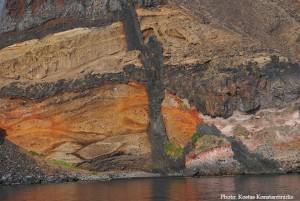
The eruption of the 17th century B.C. (The Minoan eruption)
by George Vougioukalakis*
In the late 17th century B.C. a huge eruption of Santorini’s volcano occurred. The eruption, which is also called Minoan, destroyed every trace of life from all the group of islands, keeping underneath the great layer of ashes that it deposited, the unique wealth of Prehistoric Santorini that the excavations at Akrotiri are bringing to light during the last four decades.
The huge eruption before the Minoan age occurred 21.000 years ago and gave the shape of the island in which Santorinians of the late Bronze Age inhabited. Santorini at that time was united from Aspronisi to Faros. A small channel between Faros and Aspronisi was allowing the sea to enter into a caldera, where on its centre was the top of an underwater volcano similar to the one we meet in the today’s Palea and Nea Kameni.
The first, classical dating of the eruption was based upon comparative research of the potter technique and from Egyptian sources and was defined approximately in 1500 B.C. The absolute dating that we had until April 2006 was giving at least 100 to 150 years older age and derived from three different methods: the radiocarbon, the dendrochronology dating (measurement of the yearly augmentation layers of tree trunks that live many thousands of years) and the ice-core dating (determination of the past time through the measurement of the yearly augmentation layers of the ice). The recent radiocarbon dating (April 2006) of an olive tree branch that was buried under the ashes of the Minoan eruption, gave the age between 1627 and 1600 B.C. with more likely the one of the 1613-1614 B.C.
As far as the magnitude of the eruption is concerned, the findings of intensive submarine research give the estimation that the mass of the matter from the Minoan eruption was 55 km3 magma or approximately 150 billion tons of rock. Under this estimation, the Minoan eruption of Santorini surpasses by far the one of the Tampora in 1815 (~50 km3) and it is now in the first place of volcano eruption magnitude of the last 10.000 years in the entire world.
Santorini and the neighboring islands spread in 50-60 kilometers were completely destroyed. The lack of early forerunner phenomena and the extremely fast process of the eruption sequence do not leave room for speculating that the people of the island could have abandoned it. The areas of the eastern Aegean and Minor Asia that were covered by thin ash and suffered from the volcanic winter of the following two years had serious problems of survival. The consecutive tsunamis that were caused by the eruption devastated the coasts of the nearby islands and north Crete. However, the size of these consequences in Crete, besides that there is a time inconsistency, it cannot justify the beginning of Minoan civilization’s decline.
* Dr. George Vougioukalakis, Volcanologist
Source: Santorini Guidebook
